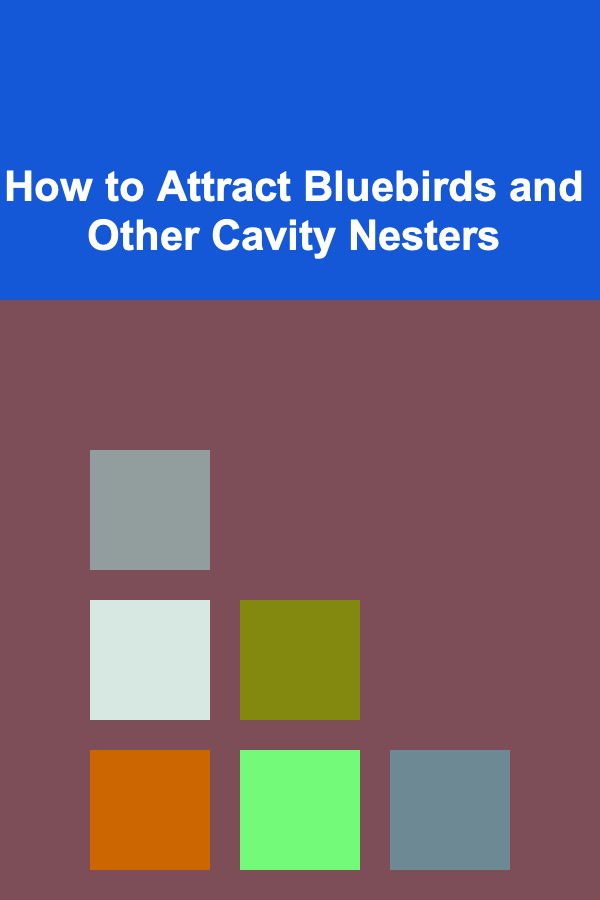
How to Attract Bluebirds and Other Cavity Nesters
ebook include PDF & Audio bundle (Micro Guide)
$12.99$6.99
Limited Time Offer! Order within the next:

Attracting bluebirds and other cavity-nesting birds to your yard is a fulfilling and rewarding experience. These birds, often colorful and captivating, add beauty to your outdoor space while playing essential ecological roles, such as pest control and seed dispersal. However, the challenge for many bird enthusiasts is how to create an environment that encourages these species to settle and breed.
This article will explore how you can attract bluebirds and other cavity nesters, from understanding their behaviors and preferences to providing the right habitats and resources.
Understanding Cavity-Nesting Birds
Cavity nesters are birds that use natural or artificial cavities (or hollows) to nest and raise their young. These birds do not build open nests in trees or on the ground. Instead, they seek out existing cavities created by natural processes such as decay or woodpecker activity. Some species, like the bluebird, may also use man-made structures like birdhouses.
Cavity-nesting birds typically prefer environments with plenty of tree cover, open fields, and access to food sources. These birds are often smaller in size, and their nesting habits vary by species. Some of the most common cavity nesters include:
- Eastern Bluebird: A small, vibrant bird known for its blue feathers, often found in open fields and meadows.
- Tree Swallows: Known for their acrobatic flight patterns and glossy blue-green feathers.
- Chickadees: Small, curious birds often found in forests or wooded backyards.
- Purple Martins: Large swallows that nest in colonies, often in specially designed birdhouses.
- Woodpeckers: Though primarily known for creating cavities, woodpeckers will also use existing cavities for nesting.
By creating the right conditions, you can attract a variety of cavity-nesting species to your yard, each contributing to the diversity and vibrancy of your local bird population.
Step 1: Provide Suitable Nesting Sites
The first step in attracting cavity nesters is providing appropriate nesting sites. This can be achieved by offering birdhouses or installing features that mimic natural cavities.
A. Birdhouses for Bluebirds and Other Cavity-Nesting Species
To attract bluebirds specifically, the placement of birdhouses is critical. These birds are particularly attracted to open fields and meadows, where they can find plenty of insects to feed on. Here are some tips for providing the ideal nesting boxes:
- Design: Bluebirds prefer houses with a round entrance hole (about 1.5 inches in diameter), and a small, clean interior. The entrance hole should not be too large, as it will allow predators like squirrels or larger birds to enter.
- Materials: Choose durable, natural materials such as untreated wood. Cedar is an excellent choice for birdhouses because it is weather-resistant, while pine provides a good, breathable structure for birds.
- Placement: Bluebird houses should be placed in open areas, such as the edge of fields, gardens, or meadows. The nest box should be mounted on a pole (not a tree) to protect the birds from predators. The ideal height is around 5 to 10 feet from the ground.
- Location: Choose locations that are free from disturbances like heavy human traffic, pets, and predators. It's important that the site is also away from dense tree cover where predators can hide.
- Seasonal Maintenance: Bluebirds use the same houses year after year, so cleaning them at the end of each breeding season is essential. Remove old nests, debris, and any signs of pests to prepare the house for new tenants.
For other cavity-nesting birds, such as tree swallows or chickadees, similar house designs and placements work well. Swallows, for example, prefer their houses mounted on poles near open fields or water sources.
B. Natural Cavities
If you're fortunate to have older trees in your yard, you're in luck. Many species of cavity-nesters prefer natural cavities. Look for dead or decaying trees with hollow trunks or branches. These trees serve as perfect natural homes for birds like woodpeckers, chickadees, and even owls.
When selecting trees to preserve, look for:
- Dead or Dying Trees: As long as they are not a safety hazard, dying trees provide an excellent habitat for cavity-nesting birds. These trees often have cavities created by natural processes like weathering or woodpecker activity.
- Proper Height: The higher the cavity, the more likely it is to attract birds, as this reduces the risk of predators.
If your trees do not have natural cavities, you can enhance their attractiveness to cavity-nesters by installing artificial nesting boxes or allowing woodpeckers to excavate new holes.
Step 2: Provide Food and Water Sources
Food and water are essential to attracting any bird species. By ensuring that your yard is rich in the nutrients cavity-nesters need, you can increase the likelihood that they will visit and stay.
A. Insect-Friendly Gardens
Insects are a primary food source for many cavity-nesting birds. Bluebirds, for example, thrive on a diet of insects such as beetles, grasshoppers, and caterpillars. To attract these birds, it's important to create a garden environment that attracts insects.
- Native Plants: Grow native plants that support local insect populations. These plants will attract caterpillars, moths, and beetles that are vital food sources for birds.
- Avoid Pesticides: If you're trying to attract birds, avoid using pesticides or herbicides in your garden. These chemicals can kill the insects that birds feed on and are toxic to the birds themselves.
- Provide a Natural Landscape: Allow some areas of your garden to remain a little wild, with fallen leaves, uncut grass, or a few bare patches of earth. These areas are perfect for attracting insects and will provide additional food sources for cavity-nesters.
B. Fresh Water
Birds need access to fresh water for drinking and bathing. A clean, shallow birdbath is a great way to provide hydration and help keep birds clean.
- Water Features: Install a birdbath or a shallow water dish. Make sure the water is kept clean and free of algae. Change the water regularly to prevent mosquitoes from breeding.
- Dripping or Moving Water: Birds are often more attracted to water that moves or drips, as the sound and movement catch their attention. Consider adding a small fountain or dripper to your water feature to entice birds.
C. Supplementary Feeders
For birds that may not find enough natural food sources, you can also provide supplementary feeders. Bluebirds, for example, enjoy mealworms and suet, especially during colder months when insects may be less abundant. If you're hoping to attract other cavity-nesters like chickadees or tree swallows, consider offering seeds such as black oil sunflower seeds or peanuts.
- Mealworm Feeders: Set up mealworm feeders near your birdhouses to encourage bluebirds to take up residence.
- Suet Blocks: Suet is high in fat and provides a vital energy source for many cavity-nesting birds during the colder months.
- Platform Feeders: Platform feeders offer a variety of food options, including seeds, nuts, and fruit, which can attract a range of cavity-nesting birds.
Step 3: Create a Safe Environment
Providing a safe and secure environment is just as important as providing food and nesting sites. Predators, such as cats, squirrels, and larger birds, can scare away or harm cavity-nesting species. By making your yard less inviting to these threats, you'll increase the chances that your feathered friends will stay.
A. Protecting Nesting Sites
To protect your birdhouses from predators, you can:
- Mount Birdhouses on Poles: Avoid placing birdhouses directly on trees, as predators like squirrels and raccoons can easily climb them. Use a smooth, metal pole or post to mount the house. You can also use baffles to prevent predators from climbing the pole.
- Add Predator Guards: Predator guards are metal or plastic devices that prevent animals from reaching the entrance hole of the birdhouse. They can be added to the house entrance or around the pole to keep raccoons and other predators away.
B. Minimize Disturbance
Try to keep your yard as quiet and calm as possible. Cavity-nesting birds, especially those with young, are easily disturbed by loud noises or frequent human activity. Respect the privacy of nesting birds, especially during the breeding season.
- Limit Foot Traffic: Avoid walking too close to your birdhouses or nesting trees. If you're checking on the birds, do so quietly and only when necessary.
- Keep Pets Indoors: Cats and dogs are natural predators of birds. Keep your pets indoors, especially during the breeding season when birds are most vulnerable.
Step 4: Offer Shelter and Nesting Materials
Besides providing food and nesting sites, offering shelter and materials for nesting can make your yard more inviting.
- Natural Shelter: Cavity-nesters like to have plenty of cover in the form of bushes, shrubs, and tall grasses. These provide shelter from predators and the elements.
- Nesting Materials: Many cavity-nesting birds, like chickadees and tree swallows, appreciate having a variety of materials to line their nests. Provide natural materials such as twigs, grasses, and feathers, as well as pet hair, cotton fluff, or string (but avoid synthetic materials that can be harmful).
Conclusion
Attracting bluebirds and other cavity-nesting birds is about creating a welcoming environment that meets their needs for food, shelter, and safety. By providing suitable nesting sites, offering abundant food sources, and ensuring a predator-free environment, you can help support a variety of cavity-nesting species in your yard. With time, patience, and the right resources, you'll be able to enjoy the vibrant beauty and lively presence of bluebirds and other cavity-nesting birds in your outdoor space.

How to Create a Cozy Reading Nook in Your Entryway
Read More
How to Decorate Your Home for New Year's Eve with Elegant Touches
Read More
How to Optimize Routes for Faster and More Efficient Deliveries
Read More
How to Practice Mindful Eating
Read More
How to Use Your Typing Skills for Content Writing and Blogging
Read More
10 Tips for Improving Patient Communication as a Radiographer
Read MoreOther Products

How to Create a Cozy Reading Nook in Your Entryway
Read More
How to Decorate Your Home for New Year's Eve with Elegant Touches
Read More
How to Optimize Routes for Faster and More Efficient Deliveries
Read More
How to Practice Mindful Eating
Read More
How to Use Your Typing Skills for Content Writing and Blogging
Read More